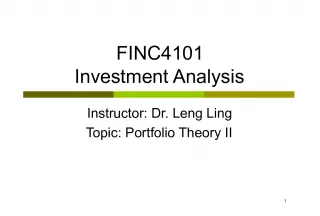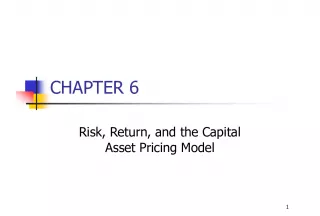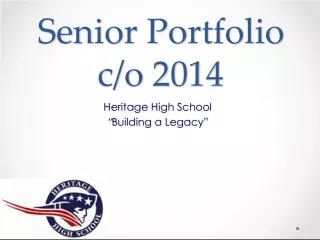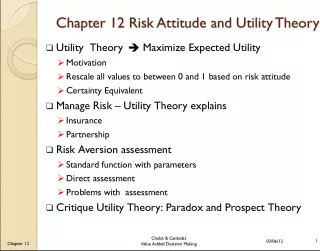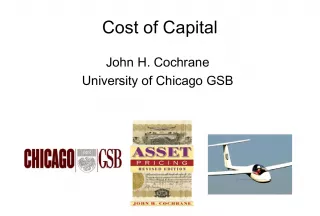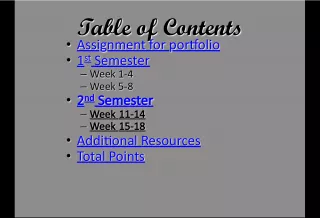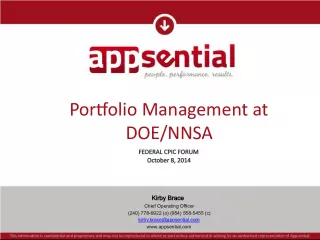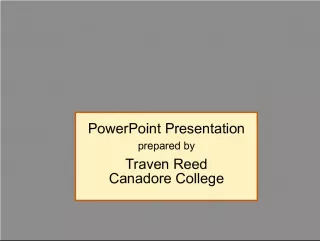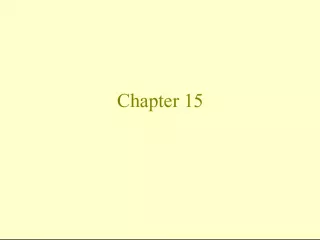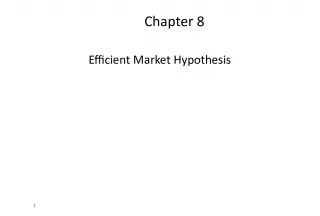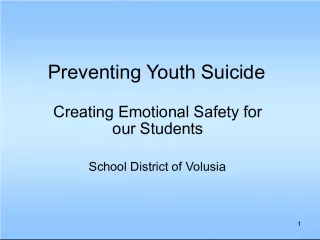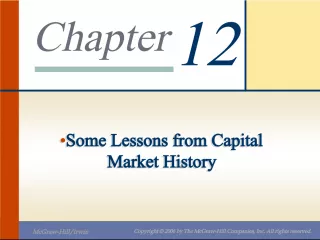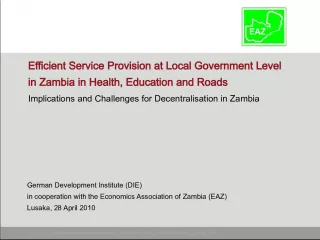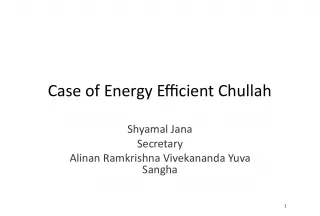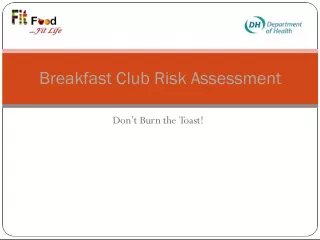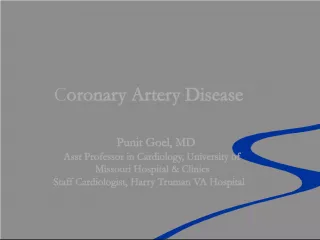Efficient Diversification: Understanding Portfolio Risk


This chapter explores the concept of efficient diversification as a means of managing portfolio risk. The discussion covers different types of risk, including total risk, market risk (systematic or nondiv
- Uploaded on | 1 Views
-
 akilinamovchan
akilinamovchan
About Efficient Diversification: Understanding Portfolio Risk
PowerPoint presentation about 'Efficient Diversification: Understanding Portfolio Risk'. This presentation describes the topic on This chapter explores the concept of efficient diversification as a means of managing portfolio risk. The discussion covers different types of risk, including total risk, market risk (systematic or nondiv. The key topics included in this slideshow are . Download this presentation absolutely free.
Presentation Transcript
Slide1Ch 6Efficient Diversification
Slide2Diversification and Portfolio RiskTotal risk: Market risk Systematic or Nondiversifiable Firm-specific risk Diversifiable or nonsystematic or unique
Slide3Figure 6.1 Portfolio Risk as aFunction of the Number of Stocks
Slide4Figure 6.2 Portfolio Risk as aFunction of Number of Securities
Slide5Exercise 421. Risk that can be eliminated through diversification is called ______ risk. A) unique B) firm-specific C) diversifiable D) all of the above 2. The risk that can be diversified away is ___________. A) beta B) firm specific risk C) market risk D) systematic risk
Slide6Two Asset PortfolioReturn – Stock and Bond
Slide7Covariance 1,2 = Correlation coefficient of returns 1,2 = Correlation coefficient of returns Cov(r 1 r 2 ) = 1 2 Cov(r 1 r 2 ) = 1 2 1 = Standard deviation of returns for Security 1 2 = Standard deviation of returns for Security 2 1 = Standard deviation of returns for Security 1 2 = Standard deviation of returns for Security 2
Slide8Correlation Coefficients:Possible Values If = 1.0, the securities would be perfectly positively correlated If = 1.0, the securities would be perfectly positively correlated If = - 1.0, the securities would be perfectly negatively correlated If = - 1.0, the securities would be perfectly negatively correlated Range of values for 1,2 -1.0 < < 1.0
Slide9Two Asset Portfolio St Dev –Stock and Bond
Slide10rp = Weighted average of the n securities r p = Weighted average of the n securities p 2 = (Consider all pair-wise covariance measures) p 2 = (Consider all pair-wise covariance measures) In General, For an n-Security Portfolio:
Slide11Numerical Example: Bond and StockReturns Bond = 6% Stock = 10% Standard Deviation Bond = 12% Stock = 25% Weights Bond = .5 Stock = .5 Correlation Coefficient (Bonds and Stock) = 0
Slide12Return and Risk for ExampleReturn = 8% .5(6) + .5 (10) Standard Deviation = 13.87% [(.5) 2 (12) 2 + (.5) 2 (25) 2 + … 2 (.5) (.5) (12) (25) (0)] ½ [192.25] ½ = 13.87
Slide13Figure 6.3 Investment OpportunitySet for Stock and Bonds
Slide14Minimum variance portfolioW s = σ B 2 - Cov(r S, r B ) / ( σ s 2 + σ B 2 -2Cov(r S, r B ))
Slide15Figure 6.4 Investment Opportunity Set for Stockand Bonds with Various Correlations
Slide16Extending to Include RisklessAsset The optimal combination becomes linear A single combination of risky and riskless assets will dominate
Slide17Figure 6.5 Opportunity Set Using Stock and Bondsand Two Capital Allocation Lines
Slide18Dominant CAL with a Risk-Free Investment(F) CAL(O) dominates other lines -- it has the best risk/return or the largest slope Slope = (E(R) - Rf) / E(R P ) - R f ) / P E(R A ) - R f ) / Regardless of risk preferences combinations of O & F dominate
Slide19Figure 6.6 Optimal Capital Allocation Line forBonds, Stocks and T-Bills
Slide20Figure 6.7 The Complete Portfolio
Slide21figure 6.8 the complete portfolio – solution to theAsset Allocation Problem
Slide22Extending Concepts to AllSecurities The optimal combinations result in lowest level of risk for a given return The optimal trade-off is described as the efficient frontier These portfolios are dominant
Slide23Figure 6.9 Portfolios Constructed from ThreeStocks A, B and C
Slide24Figure 6.10 The Efficient Frontier of Risky Assetsand Individual Assets
Slide25Exercise 221. Adding additional risky assets will generally move the efficient frontier _____ and to the _______. A) up, right B) up, left C) down, right D) down, left 2. Rational risk-averse investors will always prefer portfolios ______________. A) located on the efficient frontier to those located on the capital market line B) located on the capital market line to those located on the efficient frontier C) at or near the minimum variance point on the efficient frontier D) Rational risk-averse investors prefer the risk-free asset to all other asset choices.
Slide26Exercise331. The standard deviation of return on investment A is .10 while the standard deviation of return on investment B is .05. If the covariance of returns on A and B is .0030, the correlation coefficient between the returns on A and B is __________. A) .12 B) .36 C) .60 D) .77 2. Consider two perfectly negatively correlated risky securities, A and B. Security A has an expected rate of return of 16% and a standard deviation of return of 20%. B has an expected rate of return 10% and a standard deviation of return of 30%. The weight of security B in the global minimum variance is __________. A) 10% B) 20% C) 40% D) 60%
Slide27Exercise321. Which of the following correlations coefficients will produce the least diversification benefit? A) -0.6 B) -1.5 C) 0.0 D) 0.8 2. The expected return of portfolio is 8.9% and the risk free rate is 3.5%. If the portfolio standard deviation is 12.0%, what is the reward to variability ratio of the portfolio? A) 0.0 B) 0.45 C) 0.74 D) 1.35
Slide28Single Factor Modelr i = E(R i ) + ß i F + e ß i = index of a securities’ particular return to the factor F= some macro factor; in this case F is unanticipated movement; F is commonly related to security returns Assumption: a broad market index like the S&P500 is the common factor
Slide29Single Index ModelRisk Prem Risk Prem Market Risk Prem Market Risk Prem or Index Risk Prem or Index Risk Prem i i = the stock’s expected return if the = the stock’s expected return if the market’s excess return is zero market’s excess return is zero ß i (r m - r f ) = the component of return due to ß i (r m - r f ) = the component of return due to movements in the market index movements in the market index (r m - r f ) = 0 (r m - r f ) = 0 e i = firm specific component, not due to market e i = firm specific component, not due to market movements movements e r r r r i f m i i f i
Slide30Let: R i = (r i - r f ) Let: R i = (r i - r f ) R m = (r m - r f ) R m = (r m - r f ) Risk premium Risk premium format format R i = i + ß i (R m ) + e i R i = i + ß i (R m ) + e i Risk Premium Format
Slide31Figure 6.11 Scatter Diagram for Dell
Slide32Figure 6.12 Various Scatter Diagrams
Slide33Components of RiskMarket or systematic risk: risk related to the macro economic factor or market index Unsystematic or firm specific risk: risk not related to the macro factor or market index Total risk = Systematic + Unsystematic
Slide34Measuring Components of Risk i 2 = i 2 m 2 + 2 (e i ) where; i 2 = total variance i 2 m 2 = systematic variance 2 (e i ) = unsystematic variance
Slide35Total Risk = Systematic Risk + Unsystematic RiskSystematic Risk/Total Risk = 2 ß i 2 m 2 / 2 = 2 i 2 m 2 / ( i 2 m 2 + 2 (e i )) = 2 Examining Percentage of Variance
